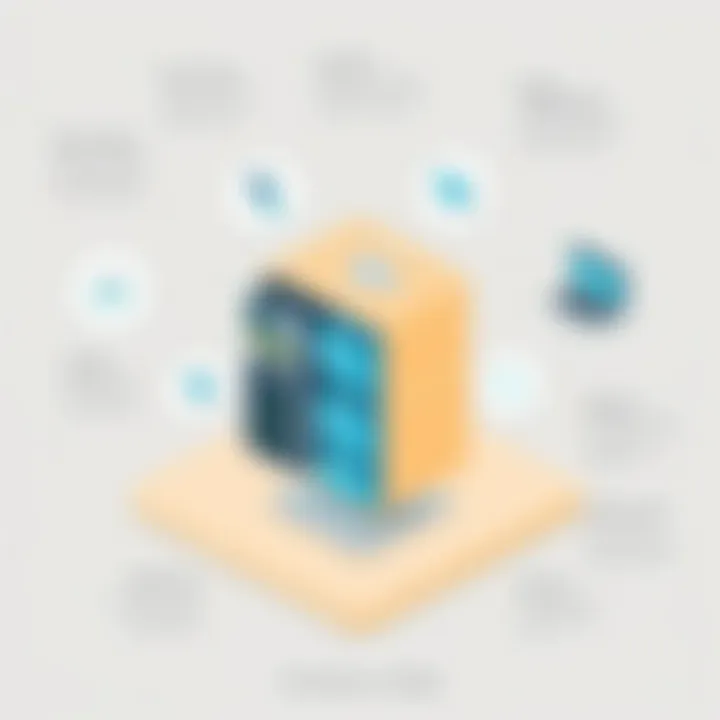Differentiating Web Servers and Application Servers


Intro
In today’s fast-paced digital landscape, understanding the infrastructure that supports our online experiences is more vital than ever. Two fundamental components of this architecture are web servers and application servers. While they might seem interchangeable at first glance, their roles and functionalities are distinct. By breaking down the distinctions between these two server types, we can better appreciate the intricacies of web application development and deployment.
This exploration will highlight how web servers focus primarily on serving static content, while application servers handle dynamic content and business logic. Being clear on these differences equips software developers, IT professionals, and tech enthusiasts with the knowledge to effectively architect and optimize their applications.
Throughout this article, we’ll dive into the core characteristics of web and application servers, discuss their interactions, and examine real-world implications of their use. From defining their roles in software development to discussing performance implications, we’ll cover a comprehensive vista of this two-server landscape. For anyone involved in developing or maintaining web applications, grasping these concepts is not just beneficial, it’s essential.
Intro to Server Types
In the ever-evolving landscape of technology, understanding the different types of servers is crucial for anyone involved in developing or managing web applications. The distinct roles played by web servers and application servers can heavily influence how an application performs and interacts with users. This article aims to clarify these roles, allowing technical professionals and enthusiasts to discern their functions, architectures, and the implications thereof.
Defining the Concept of a Server
A server, in essence, acts as a powerhouse that delivers data and services to clients, which can be devices or applications. It's like a library where information is stored, but instead of books, it has files and applications. When a user requests specific information or an action, the server processes that request and sends back the necessary resources; sort of like how a waiter takes your order and brings your food.
The core concept here is communication. Servers and clients engage in a continuous dialogue, exchanging requests and responses based on the user’s needs. In the realm of IT, in understanding this basic idea, one can lay a solid foundation for using more complex technologies effectively.
Overview of Web Servers
Web servers are specifically designed to deliver web pages to users. When you type a URL into your browser, it’s the web server that retrieves the requested content, be it HTML pages, images, or videos, sending them back to the user's browser for display. It's a straightforward process, yet the mechanism is complex and involves various interaction protocols, mainly HTTP (Hypertext Transfer Protocol).
Consider this: every time a user makes an online purchase, their request travels to a web server, which acts as the entry point and serves up all necessary information to complete that transaction, like customer reviews and product FAQs. It’s essential to recognize that, while web servers handle static content efficiently, they’re not meant to execute bone-heavy operations involving business logic; for that, they often need help from application servers.
Overview of Application Servers
Application servers step in where web servers leave off. They are more than just content handlers; they provide a platform for running applications and generating dynamic content through business logic execution. Think of it like a chef in a restaurant, preparing dishes based on customer orders while using ingredients and recipes. An application server processes complex logic and database interactions, any necessary computations, and then sends the resulting data or content back to the web server, which ultimately reaches the user.
In many scenarios, application servers enable more personalized interaction, allowing for user-specific responses or data retrieval. This might involve accessing a database to pull up user settings or preferences. They ultimately play a critical role in dynamic web application functionality, ensuring users have a smooth and tailored experience online.
Understanding these distinctions between web and application servers is the first step when navigating more intricate layers of server technology. The following sections will explore their core functions, architectural differences, and other performance considerations in greater detail.
Core Functions of Web Servers
Understanding the core functions of web servers is crucial because these servers are the backbone of how users interact with websites and web applications. They serve as the critical bridge between users and content, handling requests and delivering the necessary resources to create a seamless online experience. This section will dive into the essential roles that web servers play, examining their responsibilities in serving content, handling requests, and optimizing delivery.
Serving Static Content
One of the primary functions of a web server is to deliver static content. Static content refers to files that do not change in real-time, including HTML pages, CSS stylesheets, images, and JavaScript files. The term "static" means these files remain constant unless a developer manually updates them. When a user navigates to a website, the web server retrieves these files and sends them to the user's browser.
Benefits:
- Reduced Load Times: Because static files are stored in their entirety, they can be served quickly, resulting in minimal loading delays for users.
- Optimal Resource Management: Static content requires fewer server resources compared to dynamic content, allowing web servers to handle numerous requests efficiently.
Considerations:
- Caching strategies can be implemented to enhance performance, as frequently requested static content can be stored temporarily, reducing the need for repeated access to the server.
Handling HTTP Requests
At the heart of web server functionality lies the ability to handle HTTP requests. When a user inputs a URL or clicks a link, their browser sends an HTTP request to the server. The web server interprets this request and fetches the appropriate resources before sending them back to the user's browser. This process is crucial for maintaining effective communication between the user and the site.
Key Aspects:
- Request Methods: Web servers understand different HTTP methods like GET, POST, PUT, and DELETE, each designed for specific actions. For example, GET requests are commonly used to retrieve content, while POST requests are used to submit data.
- Status Codes: Upon receiving a request, the server responds with an HTTP status code, which informs the browser whether the request was successful, or if there were errors. Common codes include 200 for success, 404 when content isn’t found, and 500 for server errors.
This capability directly impacts user experience, as a server that efficiently handles requests provides a smoother, more responsive interaction compared to one that struggles.
Content Delivery Optimization
In today’s digital landscape, optimising the delivery of content is important for maintaining a competitive edge. Content Delivery Networks (CDNs), for instance, leverage a network of servers strategically placed around the globe to ensure that content is served from the location closest to the user.
Strategies for Optimization:
- Compression: Web servers can compress files before sending them over the network. Techniques such as Gzip or Brotli can significantly reduce the size of HTML, CSS, and JavaScript files, speeding up load times.
- Minification: This involves stripping unnecessary characters from code (like spaces and comments) without altering functionality. For instance, transforming a complex JavaScript file into a minified version can decrease load time substantially.
- Leveraging Browser Caching: By storing certain data on users’ local machines, web servers can reduce the number of requests made. This choice saves bandwidth and speeds loading times for repeat visitors.
"The efficiency of a web server in delivering content can make or break the user experience, highlighting the importance of optimizing every facet of the delivery process."
Core Functions of Application Servers
In understanding the landscape of modern web technologies, application servers play a pivotal role that often gets overshadowed by the more visible web servers. Their core functions are essential for the seamless execution of complex web applications and services, driving interactions that go well beyond static content delivery. This section delves into the main functions of application servers, illuminating how they empower developers and organizations to craft dynamic user experiences.


Executing Business Logic
At the heart of any dynamic application lies business logic—the rules and operations that define how data is processed, decisions are made, and interactions unfold. Application servers are adept at executing this logic, allowing for sophisticated operations within applications.
- Business Rules Enforcement: Application servers handle the intricate algorithms that enforce business rules. This ensures that applications behave consistently under various conditions, accommodating diverse user scenarios.
- Separation of Concerns: By isolating business logic from user interfaces, application servers enable developers to refine the backend without disrupting the frontend experience. This separation allows for greater maintainability and scalability, crucial factors in today’s fast-paced development environments.
- Performance Optimization: Many application servers employ caching strategies and resource management techniques to enhance performance. They can juggle multiple incoming requests effectively, executing business logic in a streamlined manner and thus improving response times.
In a nutshell, the ability of application servers to execute complex business logic is indispensable for delivering robust and functional web applications.
Database Interaction
Database interaction is another foundational function of application servers. These servers serve as a mediator between the client-side requests and the database systems, ensuring data is accessed, stored, and manipulated efficiently.
- Connection Management: Application servers efficiently manage database connections. They keep a pool of connections ready to serve requests, significantly reducing latency and overhead associated with repeatedly establishing connections.
- Data Integrity: Through transaction management, application servers ensure that data remains accurate and reliable, even when handling concurrent transactions. This feature is particularly vital in environments with high transaction volumes.
- Support for Multiple Database Types: Whether it’s SQL, NoSQL, or in-memory databases, application servers often provide a framework for interacting with various data storage solutions. This flexibility is vital for applications that require different storage paradigms.
When you look at how application servers facilitate database interaction, it becomes clear how they underpin the functionality that users expect from modern applications.
Support for Dynamic Content Generation
In a world where users demand personalized experiences, the ability to generate dynamic content is crucial. Application servers enable the generation of content that adapts based on user input, preferences, and real-time data.
- Personalization: By leveraging user data, application servers can tailor content, displaying relevant information that enhances user engagement. This could range from product recommendations in an e-commerce site to personalized dashboards in web applications.
- Real-time functionalities: Application servers can handle real-time updates, allowing web applications to push updates to users instantly. This is particularly relevant for applications that require timely notifications—think of social media feeds or active trading platforms.
- Integration with APIs: Through robust API integration, application servers can pull data from various services to populate content dynamically, further enriching the user experience. This integration capability is instrumental for modern applications that rely on external data.
Architectural Differences
Understanding the architectural differences between web servers and application servers is crucial for anyone involved in the design or maintenance of web applications. These distinctions not only affect performance but also determine the scalability and security of the system architecture. Each type of server plays a unique role, and comprehending these roles allows developers and IT professionals to make informed decisions regarding system design.
Client-Server Interaction
Client-server interaction forms the backbone of any web application architecture. It delineates how clients, typically web browsers or mobile applications, communicate with servers and retrieve resources or data. In a web server scenario, the interaction revolves around simple requests for static or dynamic web pages. The client sends an HTTP request, and the server responds with the requested content.
On the other hand, application servers manage a more complex interaction pattern. Here, the client’s requests often necessitate invoking specific business logic, which the application server processes before sending the result back. This entails not only fetching data but possibly manipulating it based on the inputs from the client. The nuance lies in how this interaction handles data, where web servers primarily serve files, while application servers engage in processing that involves multiple layers, such as databases and external services.
Overall, the nature of client-server interaction sets the stage for how effectively an application can scale and respond to user requests.
Request Handling Mechanisms
The way requests are handled differentiates web servers from application servers significantly. Web servers typically operate with stateless handling of requests; they do not retain session information between different user interactions. Each incoming request is treated as a new encounter. This simplicity allows web servers to respond swiftly to a high volume of requests, making them ideal for serving static content.
Application servers, in contrast, employ a more sophisticated request handling mechanism. They can maintain user session states, which enables personalized experiences such as login sessions and user preferences. Furthermore, application servers utilize middleware protocols to process requests, which can lead to better performance, but also introduces complexity. This complexity means that understanding the architecture is vital for optimizing performance and ensuring that resources are allocated effectively.
Integrated vs. Standalone Components
When discussing integrated and standalone components in server architecture, we're essentially talking about how various server technologies interact with each other. Web servers often act as standalone entities, ready to serve requests as they come in. They do what they do best yet may require external services for advanced processing, depending on the architecture in use. Common standalone web servers include Nginx and Apache, both of which focus primarily on delivering content efficiently to clients.
Application servers, however, may encompass integrated components that streamline functionalities like load balancing, caching, and logging into a single system. A robust example here can be found in frameworks like JBoss or Spring, which facilitate a seamless connection between the server and the back-end logic, allowing for easier management of both database transactions and user sessions.
Such integration comes with its own set of challenges; maintaining a coherent architecture with multiple intertwined components may complicate debugging and performance tuning processes. Therefore, it is essential to measure the benefits against the potential operational overhead.
In summary, architectural differences between web servers and application servers clarify how they serve distinct purposes in the web ecosystem. A thorough understanding of these differences enables IT professionals to devise solutions that align precisely with their technical needs and business goals.
For a deeper dive into server architectures, you can check out Wikipedia on Web Servers and Britannica on Application Servers. Understanding these fundamentals is crucial for making informed decisions regarding server selection and configuration.
Performance Considerations
When it comes to the backbone of web applications, performance is the bedrock upon which user experience stands. In today's fast-paced digital environment, understanding how web and application servers influence performance is critical. The performance aspect goes beyond mere speed; it encapsulates various metrics that directly impact both user satisfaction and operational efficiency. Thus, assessing performance considerations helps pinpoint strengths and weaknesses, enabling organizations to optimize their setups for better delivery of services.
Identifying server performance allows businesses to tailor their infrastructures. Key elements to focus on include response times, throughput, resource utilization, and system reliability. Failing to pay attention to these can lead to sluggish applications, leading to prospective users bouncing away faster than you can say "404 error."
Speed and Efficiency Metrics
Measuring the speed and efficiency of web and application servers can often feel like trying to hit a moving target. However, some standard metrics provide clarity. One pivotal metric is response time, which indicates how quickly a server can respond to requests. Lower response times improve user experience, enhancing satisfaction levels significantly, especially during peak traffic periods.
Another essential metric is throughput, which gauges the number of requests a server can handle in a specific timeframe. It is common sense; the higher the throughput, the better the performance during high-demand scenarios. Efficiency also branches into resource utilization, examining how well a server uses its CPU and memory. Optimizing this usage ensures that servers don't end up being overloaded, which could result in significant slowdowns.
Don't overlook the importance of establishing baseline performance—that is, the initial set of metrics gathered under normal conditions, helping identify bottlenecks later on. Keeping a close eye on these metrics can help engineers tweak systems before small problems escalate into large landslides. As an example, if a web server typically sees a peak load of 100 concurrent users but suddenly struggles at 80, it's time to dive into the logs and diagnose what's going wrong before it gets out of hand.
"Performance metrics are the heartbeat of system health, revealing insights that can direct optimization efforts."
Load Balancing and Scalability
As applications grow, they need to scale gracefully. Here’s where load balancing shines like a beacon. Essentially, load balancers spread incoming client requests across multiple servers. This distribution alleviates the load on any single server, preventing it from becoming a choke point while maximizing resource utilization.
In practical terms, when one server is busy answering requests, another can step in to handle the overflow, smoothing out any peaks in traffic. Load balancing is increasingly vital; as user bases grow, it becomes clear that reliance on a single server model is a fatal flaw.


With scalability, we encounter two types: vertical and horizontal. Vertical scaling involves beefing up a single server to handle more load—adding more CPU power or memory where necessary. In contrast, horizontal scaling entails adding more servers to distribute the load more effectively. While vertical scaling is simpler in the short term, horizontal scaling offers a more sustainable long-term strategy. Scalability isn’t just about managing current demand; it's also about accommodating future growth without throwing out the old system and starting anew.
In short, thorough awareness and proactive measures about performance considerations lead to more robust systems. By focusing on speed metrics and effective load balancing, organizations can ensure that their applications run as smoothly as possible, keeping users engaged and satisfied.
Security Implications
Understanding the security implications related to web servers and application servers is paramount in today's interconnected digital age. Both types of servers play distinct but complementary roles in serving web applications, and their security concerns vary accordingly. For software developers, IT professionals, and tech enthusiasts, comprehending these vulnerabilities is not just an academic exercise but a critical aspect for ensuring robust and secure applications.
In a landscape where cyber threats are constantly evolving, knowing how to fortify servers against potential attacks can protect sensitive data and maintain the integrity of applications. Web servers are generally susceptible to external threats, whereas application servers often face risks from internal vulnerabilities. This dichotomy affects how security measures are implemented and how professionals must approach server architecture.
Vulnerabilities Unique to Web Servers
Web servers primarily serve static content and handle HTTP requests, making them an attractive target for cybercriminals. One of the most common vulnerabilities is Distributed Denial of Service (DDoS) attacks, where multiple compromised systems flood the server with excessive requests, leading to downtime and service unavailability. Another notable threat is SQL injection, which exploits vulnerabilities in the data-driven aspect of web servers that interact with databases, allowing attackers to access or manipulate data unlawfully.
To add further complexity, web servers often manage sensitive information such as user login credentials. If these servers aren't adequately secured, attackers may exploit cross-site scripting (XSS) to inject malicious scripts into web pages that will run in users' browsers, leading to data theft or session hijacking.
Furthermore, misconfiguration remains a top contributor to web server vulnerabilities. Simple oversights in server settings can expose directories or lead to unintended data leaks. Good practices such as regular security audits and configuration management help in mitigating these risks.
"The best defense is a good offense; being proactive about web server security means fewer headaches down the line."
Application Server Security Features
On the flip side, application servers come equipped with more inherent security features aimed at mitigating the unique vulnerabilities they face. One of the biggest strengths is their ability to manage user authentication and authorization, effectively ensuring that only legitimate users can access sensitive application portions. This includes advanced practices like Tokenization, which securely replaces sensitive data with unique identifiers.
Application servers also benefit from firewall and intrusion detection systems (IDS) specifically designed to monitor incoming and outgoing traffic. This can help identify potential threats before they infiltrate the server system. Moreover, many application servers incorporate data encryption measures for securing data in transit and at rest, thus preventing unauthorized access.
In terms of updating and patch management, application servers typically offer a more streamlined process compared to web servers. This enables quicker responses to newly identified vulnerabilities, ensuring that security loopholes are addressed promptly.
Additionally, the use of a microservices architecture within application servers enhances security by isolating different functionalities, thereby containing potential breaches to smaller sections of the application rather than the entire system.
Common Use Cases
Understanding common use cases for web servers and application servers is pivotal to grasping the larger narrative of server technology. These use cases showcase how each server type fulfills distinct yet complementary roles in the intricate web of technology. By exploring these scenarios, one can appreciate the strategic placements of web and application servers in real-world applications, enabling better decisions in architecture and infrastructure design.
Web Servers in Action
Web servers primarily serve static content—think HTML pages, images, and stylesheets. A quintessential example of a web server in action is a small e-commerce business hosting its website through an Apache HTTP Server. When a user types in the URL, the server processes the HTTP request and delivers the homepage, showcasing products in an easy-to-navigate format.
Using web servers can significantly improve the user experience since they can handle multiple requests simultaneously, serving thousands of users efficiently. This is especially pertinent during peak shopping seasons, like Black Friday, where high traffic to the site can be expected. The web server utilizes various methods such as caching and load balancing to manage multiple connections, ensuring swift access to resources.
Moreover, a web server can integrate with Content Delivery Networks (CDNs), such as Cloudflare or Fastly, which helps accelerate content delivery by caching content closer to the user, thereby reducing latency. This combination leads to a performance powerhouse, ensuring that users don’t just visit the site but are likely to stay and enjoy their experience.
Application Server Scenarios
On the other side of the fence, application servers take the baton by managing and executing business logic. A common scenario could be a banking system, where an application server like IBM WebSphere handles user transactions, calculates balances, and applies business rules—all while interacting with a database server to fetch or store data.
Imagine a user wanting to transfer funds through a banking app. Once they hit 'send', the application server springs into action, ensuring that the funds are deducted and appropriately allocated to the recipient. This tightly integrated dance of acquiring data, processing it, and communicating results back to the user is what makes application servers invaluable in businesses handling real-time data.
Furthermore, application servers excel in orchestrating microservices, which enables better scalability and fault tolerance. In a microservices architecture, different services can be updated independently, allowing for seamless development and deployment cycles, which is vital in today’s fast-paced digital landscape. With the advent of containerization technologies such as Docker, deploying these application servers has become both flexible and efficient, freeing developers to focus more on functionality than the underlying infrastructure.
In summary, knowing the common use cases for both web and application servers reveals not just their operational functionalities, but also their potential impacts on business efficiency and user satisfaction. It highlights their roles in ensuring that digital marketplaces function smoothly in our ever-connected world.
"The choice between a web server and application server can significantly influence how one’s technology stack performs, delivering either efficiency or complexity depending on the design choice."
Thoughtful integration of both server types enables businesses to leverage their strengths effectively. As users demand quicker responses and richer experiences, understanding these common use cases becomes essential for developers, IT managers, and tech enthusiasts alike.
Integration Between Web and Application Servers
The interplay between web servers and application servers is a dance of technical finesse that plays a pivotal role in how web applications serve users. This integration is not just a convenience; it's the backbone of efficient web operations. Understanding this synergy is crucial, especially given the rapidly evolving landscape of technology where demands are greater—and more nuanced—than ever before. By breaking down the nature of their integration, we can appreciate how these two server types complement each other in delivering dynamic content to end-users.
When discussing the integration of web and application servers, several critical elements come to mind:
- Functionality: Each type of server excels in its domain—web servers handle static content, while application servers are built for complex logic and data processing. The ability for them to communicate effectively allows for an optimal user experience.
- Performance: A well-integrated setup minimizes latency issues, making sure that users receive information quickly. The use of caching and load balancing strategies can help distribute the workload, thereby enhancing responsiveness.
- Security: Integrating web and application servers effectively can bolster security, as it allows for more controlled access to sensitive data and application logic.
The benefits of this integration cannot be overstated. For instance, it enables seamless user interactions with web applications. When a user requests a dynamic page, the web server retrieves the necessary data from the application server, ensuring that the result is not only accurate but also delivered promptly. This interaction can lead to more nuanced user experiences and provides the configuration flexibility needed to adapt to changing requirements.
However, there are several considerations that need to be kept in mind:
- Communication Protocols: The method of data exchange between the servers must be efficient. Common protocols like HTTP and HTTPS need to be optimized to minimize bottlenecks.
- Scalability: As user demands grow, the integration should scale accordingly. Leveraging cloud solutions can aid both servers in handling increased traffic.
Inter-Server Communication Protocols


When we dig deeper into the specifics of integration, one of the most crucial aspects to analyze is the communication protocols that facilitate interaction between web and application servers. This communication serves as the bridge that connects distinct components, allowing them to work in concert. Without robust protocols in place, even the best architectural frameworks could falter.
Typical protocols utilized in this context include:
- HTTP/HTTPS: The stalwarts of web communication, these protocols form the bedrock of how data is transmitted between clients and servers. They govern requests, responses, and the exchange of information, ensuring that the servers are well-aligned.
- WebSocket: When real-time interaction is required, such as in chat applications or live updates, WebSockets come into play. They maintain a persistent connection, allowing for two-way communication, creating a more interactive experience.
Additionally, there are various data interchange formats to consider. JSON is renowned for its lightness and ease of use when compared to XML. This rapid serialization and deserialization make JSON a preferred choice in many modern applications.
A key technical aspect worth pointing out is the importance of API design. We often utilize RESTful APIs for interaction between servers. They facilitate a clear and organized communication channel that follows best practices and reduces confusion.
"Integration isn’t just about making two things work together; it’s about creating a seamless user experience that hides the complexity behind functional simplicity."
Middleware Solutions
In many modern architectures, middleware solutions act as the connective tissue between web and application servers, providing essential functionality that enhances the integration process. Middleware comprises software that sits between the operating system and applications or between different applications themselves, streamlining communication and data management.
The role of middleware can include:
- Message Queuing: Technologies like RabbitMQ or Apache Kafka allow different components of an architecture to communicate asynchronously, which enhances performance and reliability.
- Data Management: Middleware can also manage communications related to databases, ensuring that data from an application server can be easily accessed by a web server without direct interaction.
- Transaction Management: Some middleware offers transaction management capabilities, ensuring that processes like financial transactions remain consistent and reliable even if one part of the system fails.
This layer of abstraction not only helps in integrating different server types but also provides higher-level functionalities such as load balancing, authentication, and data transformation. Consequently, using middleware can significantly reduce the complexity of inter-server communications.
As environments become more distributed and microservices architectures gain traction, middleware solutions will likely continue to evolve, providing even more sophisticated tools to facilitate seamless web and application server integrations.
Future Trends in Server Technology
As we peer into the future of server technology, it becomes clear that the landscape is shifting dramatically. The rapid evolution in software development, cloud computing, and client needs is steering us toward a new generation of solutions. In this context, web and application servers are not merely participants; they are at the forefront of this transformation. Understanding the future trends in server technology is essential for anyone involved in technology, and particularly for software developers, IT professionals, and tech enthusiasts aiming to keep pace with advancements in the field.
Microservices Architecture
Microservices architecture represents a departure from traditional monolithic application design. In a microservices setup, an application is broken down into smaller, independent components that communicate via APIs. This approach allows developers to deploy and scale each service independently, promoting flexibility and resilience.
- Benefits:
- Scalability: Each microservice can be scaled independently according to demand, leading to more efficient resource allocation.
- Enhanced Recovery: In the event of a failure, the architecture allows other services to continue operating, minimizing downtime.
- Language Agnostic: Developers can use different programming languages and technologies for different microservices, allowing for a better fit for specialized tasks.
—> "In a world where speed and agility reign supreme, microservices architecture allows teams to innovate continuously and respond to market changes swiftly."
Moreover, integrating microservices with cloud platforms enhances their operational efficiency. The architectural approach thrives when paired with containerization so that services can be deployed quickly and with greater consistency. This trend is vital for companies striving to agile create and deliver capabilities, making it a significant focal point in server technology discussions.
Serverless Computing
Serverless computing is another trend gaining traction that complicates the traditional web and application server models. Despite the name, serverless architecture does not eliminate servers; it abstracts server management away from the developer. Providers like AWS Lambda and Google Cloud Functions enable developers to focus on writing code rather than worrying about the underlying infrastructure.
- Key Considerations:
- Cost Efficiency: Organizations pay only for the compute time they consume, potentially reducing overall infrastructure costs.
- Automatic Scaling: Serverless platforms automatically scale based on the volume of requests, ensuring optimal performance without manual intervention.
- Faster Prototyping: Developers can rapidly prototype and iterate on applications, which accelerates the overall development lifecycle.
This technology shifts responsibility for operational concerns like maintenance and scaling to the service provider. It changes the developer's approach to building applications, focusing more on functionality and user experience rather than the intricacies of deployment.
Finale
Understanding the differences between web servers and application servers holds significant weight in the world of technology today. As businesses and developers seek to optimize performance and deliver seamless user experiences, knowing which server architecture to choose can make or break a project.
Web servers primarily handle direct requests from clients, often answering with static content or minimal dynamic content through simple scripting. Conversely, application servers enable complex business logic and dynamic content generation, acting as the engine behind robust applications. This fundamental division underscores a key point: the choice of server can directly impact not only system efficiency but also the scalability of applications.
A thorough comparison reveals several crucial elements:
- Content Delivery - Understanding the primary role of web servers in efficiently delivering static content ensures developers leverage caching effectively.
- Application Logic - Application servers' capacity to manage complex processes and data transactions highlights their necessity in enterprise-level applications.
- Performance Optimizations - Recognizing how load balancing and resource allocation vary between the two can lead to improved system responsiveness.
Furthermore, adopting varying operational strategies can lead to significant benefits for organizations. It encourages careful consideration of how web servers and application servers can interact, ensuring a harmonized system architecture. By thoughtfully choosing the right server based on the specific requirements of a project, organizations position themselves to better meet user demands and anticipate future growth.
As the technology landscape continues to evolve, the ability to distinguish between these server types not only aids in immediate project execution but also equips professionals with insights necessary for future innovations.
Summary of Key Differences
- Operation Focus: Web servers serve webpage content, while application servers run the business logic and complex tasks.
- Request Handling: Web servers handle HTTP requests directly, whereas application servers often process business logic before sending responses.
- System Role: Web servers simplify interfaces and manage static content, while application servers drive interaction, data manipulation, and dynamic content generation.
In essence, these distinctions must be highlighted for developers to effectively deploy their applications and optimize resources.
Final Thoughts on Choosing the Right Server
When it comes to choosing the right server, weighing the needs of the application against server capabilities is vital. For developers and enterprises, understanding the functional delineation is not just about following trends—it's about strategic decision-making. The right server aids in prioritizing user experience, leveraging system capabilities, and aligning with organizational goals.
For instance, small websites with static content may fare well with simply a web server like Apache, which provides a robust and proven solution. However, for larger applications where complex database interactions are frequent, opting for an application server, like JBoss, may be integral to ensuring smooth operations and user satisfaction.
Ultimately, the choice boils down to a blend of technical requirements, future scalability, and the anticipated volume of user interaction. Staying ahead of technological developments and their implications allows organizations to make informed decisions that can lead to sustainable success. For further insights, you may refer to resources on Wikipedia or technical forums such as Reddit.
By maintaining a comprehensive perspective on the functionalities and potentials of web servers and application servers, IT professionals can adeptly navigate the evolving digital landscape.



